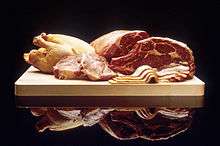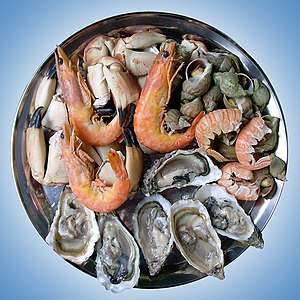Rat meat
Rat meat is the meat of various species of rat: medium-sized, long-tailed rodents. It is a food that, while taboo in some cultures, is a dietary staple in others.[1][2] Taboos include fears of disease or religious prohibition, but in many places, the high number of rats has led to their incorporation into the local diets.
Regionally
Americas
Rat stew is a local specialty from West Virginia that originated from a collapse in the mining industry.[3] The dish features as part of roadkill cuisine and has appeared in the Marlington Roadkill Cook-off.[4]
Asia
In some cultures, rats are or have been limited as an acceptable form of food to a particular social or economic class. In the Mishmi culture of India, rats are essential to the traditional diet, as Mishmi women may eat no meat except fish, pork, wild birds and rats.[5] Conversely, the Musahar community in north India has commercialised rat farming as an exotic delicacy.[6]
Ricefield rat (Rattus argentiventer) meat is eaten in Vietnamese,[7][8][9][10] Taiwanese,[11][12][13] Filipino, Cambodian, and Spanish cuisine. Rat-on-a-stick is a roasted rat dish consumed in Vietnam and Cambodia.[14]
Aborigines along the coast in southern Queensland, Australia, regularly included rats in their diet.[15]
A 2020 study on wildlife trade in three southern Vietnamese provinces found that 55 percent of the field rats sold in tested restaurants were carrying a coronavirus.[16]
Europe
In France and Victorian Britain rich people ate rat pie. During food rationing due to World War II, British biologists ate laboratory rats, creamed.[17]
A recipe for grilled rats, Bordeaux-style, calls for the use of alcoholic rats who live in wine cellars. These rats are skinned and eviscerated, brushed with a thick sauce of olive oil and crushed shallots, and grilled over a fire of broken wine barrels.[18][19][20][21][22]
In Valencia, Spain, Ricefield rat (Rattus argentiventer) meat was immortalized by Vicente Blasco Ibáñez in his novel Cañas y barro. Along with eel and local beans known as garrafons, rata de marjal (marsh rat) is one of the main ingredients in traditional paella (later replaced by rabbit, chicken and seafood).[23]
South America
Elsewhere in the world, rat meat is considered diseased and unclean, socially unacceptable, or there are strong religious proscriptions against it. Islam and Kashrut traditions prohibit it, while both the Shipibo people of Peru and Sirionó people of Bolivia have cultural taboos against the eating of rats.[24][25]
Polynesia
In the traditional cultures of the Hawaiians and the Polynesians, rat was an everyday food for commoners. When feasting, the Polynesian people of Rapa Nui could eat rat meat, but the king was not allowed to, due to the islanders' belief in his "state of sacredness" called tapu.[26] In studying precontact archaeological sites in Hawaii, archaeologists have found the concentration of the remains of rats associated with commoner households accounted for three times the animal remains associated with elite households. The rat bones found in all sites are fragmented, burned and covered in carbonized material, indicating the rats were eaten as food. The greater occurrence of rat remains associated with commoner households may indicate the elites of precontact Hawaii did not consume them as a matter of status or taste.[27]
As food for pets
Rats are a common food item for snakes, both in the wild, and as pets. Adult rat snakes and ball pythons, for example, are fed a diet of mostly rats in captivity. Rats are readily available (live or frozen) to individual snake owners, as well as to pet shops and reptile zoos, from many suppliers. In Britain, the government prohibited the feeding of any live mammal to another animal in 2007. The rule says the animal must be dead before it is given to the animal to eat. The rule was put into place mainly because of the pressure of the RSPCA and people who said the feeding of live animals was cruel.
See also
References
- Newvision Archive (2005-03-10). "Rats for dinner, a delicacy to some, a taboo to many". Newvision.co.ug. Archived from the original on 2012-09-22. Retrieved 2012-09-24.
- "Rat meat taboo". Retrieved 2012-09-24.
- Worrall, Simon (2015-12-20). "What's Best, Worst, and Most Weird About American Food". News.nationalgeographic.com. Archived from the original on 2016-01-05. Retrieved 2016-01-10.
Rat stew was born out of lean times as a result of the collapse of the mining industry
- Pollack, Hilary (2016-01-02). "America's Most Beloved Regional Dishes Have Dark and Fascinating Histories | MUNCHIES". Vice. Archived from the original on 2016-01-10. Retrieved 2016-01-10.
There were other [people] who actually celebrated the eating of rat as a culinary cultural inheritance, to the point where in Marlinton, West Virginia, for instance, they hold this annual roadkill cookoff in order to celebrate the eating of roadkill in West Virginia. When I visited the annual roadkill cookoff in Marlington, there were two folks preparing rat dishes.
- Mills, J. P. (1952). "The Mishmis of the Lohit Valley, Assam". The Journal of the Royal Anthropological Institute of Great Britain and Ireland. 82 (1): 1–12. doi:10.2307/2844036. JSTOR 2844036.
- Musahar Hindus commercialise rat farming Archived February 21, 2009, at the Wayback Machine
- "Rats Back on the Menu in Vietnam". Abcnews.go.com. 2006-01-06. Archived from the original on 2015-12-24. Retrieved 2016-01-10.
- "Vietnamese eat rats and are aggressive, Stanford professor says in article, triggering online uproar". Mercurynews.com. February 2013. Archived from the original on 2015-12-24. Retrieved 2016-01-10.
- Sou Vuthy (2012-09-12). "Rat meat on the menu at the Vietnam border, Lifestyle, Phnom Penh Post". Phnompenhpost.com. Archived from the original on 2015-12-24. Retrieved 2016-01-10.
- "Would You Ever Eat a Rat? VIDEO : Dining with Death". TravelChannel.com. Archived from the original on 2014-08-17. Retrieved 2016-01-10.
- Jennings, Ralph (28 January 2008). Macfie, Nick (ed.). "No ratatouille on Taiwan menu, but plenty of rat". Reuters. CHIAYI, Taiwan. Archived from the original on 9 February 2011. Retrieved 3 September 2016.
- HUANG, ANNIE (10 February 2002). "Eat, Drink, Man, Rodent". The Item. 107 (118). CHIAYU, Taiwan. p. 10A. Retrieved 3 September 2016.
- William Campbell (1915). "Sketches from Formosa". p. 131.
XXII BREAKFASTING ON RATS
- Molloy, M.J.; Duschinsky, P.; Jensen, K.F.; Shalka, R.J. (2017). Running on Empty: Canada and the Indochinese Refugees, 1975-1980. McGill-Queen's Studies in Ethnic History. MQUP. p. 323. ISBN 978-0-7735-5063-6. Retrieved July 7, 2017.
- Hobson, Keith A.; Collier, Stephen (1984). "Marine and Terrestrial Protein in Australian Aboriginal Diets". Current Anthropology. 25 (2): 238–240. doi:10.1086/203120.
- https://www.nytimes.com/2020/06/19/science/coronavirus-rats-vietnam.html
- Jared M. Diamond (January 2006). Collapse: How Societies Choose to Fail Or Succeed. Penguin. pp. 105–. ISBN 978-0-14-303655-5.
creamed rat.
- Calvin W. Schwabe (1979). Unmentionable Cuisine. University of Virginia Press. pp. 204–. ISBN 978-0-8139-1162-5. Archived from the original on 2016-09-11.
- "Cooking Rats and Mice". Archived from the original on 2016-06-20.
- "Cooking Rats and Mice". Archived from the original on 2016-05-28.
- "Archived copy" (PDF). Archived (PDF) from the original on 2016-08-08. Retrieved 2016-06-23.CS1 maint: archived copy as title (link)
- "Grilled Rats and Other Weird Halloween Recipes". Archived from the original on 2016-07-22.
- Manuel Vázquez Montalbán, La cocina de los mediterráneos, Ediciones B – Mexico
- Behrens, Clifford A. (September 1986) Shipibo Food Categorization and Preference: Relationships between Indigenous and Western Dietary Concepts. American Anthropologist, Nathan New Series, Vol. 88, No. 3. pp. 647–658.
- Priest, Perry N. (October 1966) Provision for the Aged among the Sirionó Indians of Bolivia. American Anthropologist, New Series, Vol. 68, No. 5. pp. 1245–1247
- Leach, Helen. (February 2003) Did East Polynesians Have a Concept of Luxury Foods? World Archaeology, Vol. 34, No. 3, Luxury Foods. pp. 442–457.
- Kirch, Patrick V.; Sharyn Jones, O'Day (2003). "New Archaeological Insights into Food and Status: A Case Study from Pre-Contact Hawaii". World Archaeology. 34 (3): 484–497. doi:10.1080/0043824021000026468.
| Wikimedia Commons has media related to Rat meat. |

